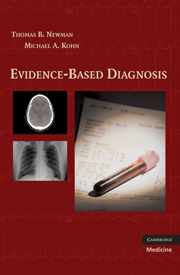Book contents
- Frontmatter
- Contents
- Preface
- Acknowledgments & Dedication
- Abbreviations/Acronyms
- 1 Introduction: understanding diagnosis and diagnostic testing
- 2 Reliability and measurement error
- 3 Dichotomous tests
- 4 Multilevel and continuous tests
- 5 Critical appraisal of studies of diagnostic tests
- 6 Screening tests
- 7 Prognostic tests and studies
- 8 Multiple tests and multivariable decision rules
- 9 Quantifying treatment effects using randomized trials
- 10 Alternatives to randomized trials for estimating treatment effects
- 11 Understanding P-values and confidence intervals
- 12 Challenges for evidence-based diagnosis
- Answers to problems
- Index
- References
12 - Challenges for evidence-based diagnosis
Published online by Cambridge University Press: 04 August 2010
- Frontmatter
- Contents
- Preface
- Acknowledgments & Dedication
- Abbreviations/Acronyms
- 1 Introduction: understanding diagnosis and diagnostic testing
- 2 Reliability and measurement error
- 3 Dichotomous tests
- 4 Multilevel and continuous tests
- 5 Critical appraisal of studies of diagnostic tests
- 6 Screening tests
- 7 Prognostic tests and studies
- 8 Multiple tests and multivariable decision rules
- 9 Quantifying treatment effects using randomized trials
- 10 Alternatives to randomized trials for estimating treatment effects
- 11 Understanding P-values and confidence intervals
- 12 Challenges for evidence-based diagnosis
- Answers to problems
- Index
- References
Summary
Introduction
We wrestled for a long time with the question of whether to include the term “evidence-based” in the title of this book. Although both of us are firm believers in the principles and goals of evidence-based medicine (EBM), we also knew that the term “evidence-based” would be viewed negatively by some potential readers (Grahame-Smith 1995; Lancet 1995; Healy 2006). We decided to keep “evidence-based” in the title and use this chapter to directly address some of the criticisms of EBM, many of which we believe have merit. We also recognize that, as elegant and satisfying as evidence-based diagnosis is, there are some very real barriers to applying it in a clinical setting. These barriers are the second topic of this chapter. Finally, we end the book with some thoughts on the future of evidence-based diagnosis and why it will be increasingly important.
Criticisms of evidence-based medicine
EBM overvalues randomized blinded trials and denigrates other forms of evidence, including clinical experience
EBM is frequently misrepresented as requiring randomized blinded trials (or better yet, a systematic review of such trials) to prove that a treatment is useful. This has been humorously illustrated in a “systematic review” of “Parachute Use to Prevent Death and Major Trauma Related to Gravitational Challenge” (Smith and Pell 2003). The authors found no controlled trials of parachute use for the “gravitationally challenged” (people jumping out of airplanes) and concluded that “everyone might benefit if the most radical protagonists of evidence based medicine organised and participated in a double blind, randomised, placebo controlled, crossover trial of the parachute.”
- Type
- Chapter
- Information
- Evidence-Based Diagnosis , pp. 239 - 254Publisher: Cambridge University PressPrint publication year: 2009



